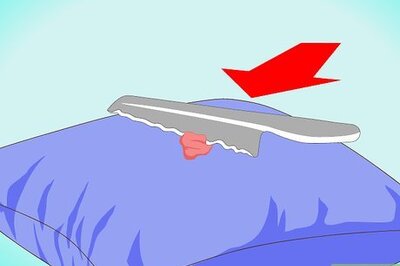
views
X
Expert Source
Audra BarriosMarine Biologist & Reptile Specialist
Expert Interview. 18 August 2020.
Cleaning a New Aquarium
Look for an aquarium with grating or holes at the top to provide ventilation. Ventilation is important, as it allows clean air to circulate into the cage. Your cage must allow your gecko to get fresh air, but make sure the top is sturdy, particularly if you have other pets in the house. You want to keep your geckos in and your other pets out! You can even use plastic storage boxes for a cage, but make sure you drill ventilation holes in the top.
Wash the aquarium thoroughly with soap and water. While spot cleaning will suffice most of the time, it only works when you have a clean cage to begin with. Make sure to thoroughly wash the aquarium when you get it with soap and water. Scrub it down with the mixture, then rinse it out several times with clean water. Use hot water for the most cleaning power.
Disinfect the cage after drying it with paper towels. Use a reptile-safe disinfectant, which you can find at the pet store, or a natural cleaner like vinegar or Simple Green. Apply the solution to the interior and exterior of the cage, making sure you soak it thoroughly. Leave it for 30 minutes before rinsing out the aquarium several times. When using bleach, make sure you dilute it with water so the bleach is no more than 10% of the solution.
Wash and disinfect any items that are going into the cage. You may have hiding spots, rocks, or other objects for the cage. Wash them with soap and water and then apply the disinfecting solution. Let them sit for 30 minutes before rinsing them thoroughly.
Rinse and condition the substrate if you're using sand. To rinse the sand, pour it into a bowl and run hot water into it. Stir it around, then let the sand settle. Pour the water off and repeat a couple of times. With the last round, use a water conditioner in the water you rinse with, one meant to remove chlorine and heavy metals. You can find water conditioners in the aquarium section of most pet stores, and it's the same type you'd use for your geckos' drinking water. You just add droplets to the water in the ratios given by the manufacturer. To dry the sand out, spread it in a single layer in the oven at 225 °F (107 °C) for 30 minutes.
Make sure everything is dry before you put it together. Moisture provides a breeding ground for bacteria and disease. Wipe everything down with paper towels, then leave it to air dry. Let the cage and all the objects in it dry separately until you are sure they are completely dry. Assemble the cage with the substrate in the bottom.
Doing Spot Cleaning
Put gloves on before you clean the cage. Leopard geckos, like many types of geckos, can carry a wide variety of bacteria. It's best to protect yourself by wearing disposable gloves that you can toss right after cleaning, disposing of the bacteria, too. Reptiles can carry Salmonella so you want to make sure to protect yourself. Their food may carry diseases, too.
Look for the corner your geckos defecate in. Usually, your geckos will pick 1 corner of the cage and use that spot over and over for going to the bathroom. If you identify it early on, that will make spot cleaning a lot easier.
Use a paper towel to remove waste from the tank every day. Check your gecko's tank daily, and when you see waste, simply use a paper towel to scoop it out. It's essentially dry, so picking it up is not that messy. You can also do this every other day instead, but you don't want to let it build up, as the cage will get messy very quickly. If you're using paper towels as a substrate, you should replace the paper towel in that corner daily or every time you find feces on it.
Take out any dead food, as well. Most geckos eat live food, such as crickets. Sometimes, however, one will die, and then your gecko won't want to eat it. As this happens, use a clean paper towel to remove the dead prey.
Deep Cleaning the Cage
Wear latex or nitrile gloves to clean the tank. Because geckos carry bacteria, it's best to put on gloves when doing this task. That way, you can just throw the gloves away at the end of the cleaning session. You can pick up these gloves at most stores, including drug stores, pet stores, and many grocery stores.
Move your gecko to a holding cage. You can use a travel cage, for instance, or even just a small plastic bin with holes in it so your gecko can breathe. You need your gecko out of the cage so you can clean it thoroughly. Make sure the plastic bin you use has a tight-fitting lid so your little critter can't escape!
Take everything out of the cage. Remove any enrichment items, such as rocks, hiding places, or toys. Take the water bowl out as well. Once all the objects are out, dump the substrate into the trash. You'll need to replace the substrate with a clean batch. For geckos, that's typically very fine play sand with a grain size of 0.5 millimetres (0.020 in) or less. The package should have the grain size, but you can use a ruler to look at the grain size and make sure it's fine enough. For geckos under 6 months, use paper towels and replace them once a week.
Clean everything with soap and water first. Scrub down the cage with warm, soapy water. You can use a dishwashing detergent for instance, or a soap meant for gecko cages. Rinse it out thoroughly to remove the soap suds. Repeat the process for all the objects in the cage. This process helps clear off any organic debris, such as feces or food.
Dry everything thoroughly. Before applying a disinfectant, you should use paper towels to dry off the cage and the items for the cage. That way, you won't dilute the disinfectant you decide to use on the cage.
Disinfect the cage and items. Use a reptile-safe disinfectant, which you can find at most pet stores. Spray or wipe the cleaner on and then leave it for the time period recommended by the manufacturer. You may need to leave it as long as 30 minutes. If you don't want to get a special cleaner, try diluted bleach (1 part bleach to 9 parts water) or a bleach alternative. However, you must rinse the items very thoroughly before returning the gecko to the cage. Another option is using steam to disinfect the cage. You can find steam cleaners specifically for cleaning reptile cages, and steam is effective at killing bacteria.
Rinse everything thoroughly. Once the disinfectant has sat on the cage and other items for the recommended amount of time, use clean water to rinse everything off. Make sure to give it a thorough rinsing, as fumes could be harmful to your reptile.
Dry everything with paper towels. The final step is to make sure everything is thoroughly dry so that you don't encourage the growth of bacteria. After drying everything off, let it sit out to air dry completely. Once it is, put in new (clean) substrate and add the items back to the cage. Place your gecko back in its now clean home. Repeat this process once a month.
Wash your hands thoroughly when you're done. Clean your hands with soap and warm water, making sure to scrub for at least 20 seconds before rinsing. Even if you're wearing gloves, you can come into contact with bacteria, so it's best to wash your hands at the end of cleaning the tank.




















Comments
0 comment